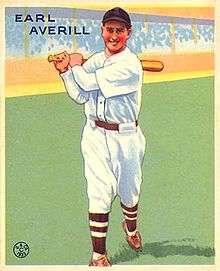Earl Averill
Howard Earl Averill (May 21, 1902 – August 16, 1983) was an American professional baseball player. He played in Major League Baseball (MLB) as a center fielder from 1929 to 1941, including 11 seasons for the Cleveland Indians. He was a six-time All-Star (1933–1938) and was elected to the Baseball Hall of Fame in 1975.
| Earl Averill | |||
|---|---|---|---|
 | |||
| Center fielder | |||
| Born: May 21, 1902 Snohomish, Washington | |||
| Died: August 16, 1983 (aged 81) Everett, Washington | |||
| |||
| MLB debut | |||
| April 16, 1929, for the Cleveland Indians | |||
| Last MLB appearance | |||
| April 25, 1941, for the Boston Braves | |||
| MLB statistics | |||
| Batting average | .318 | ||
| Home runs | 238 | ||
| Runs batted in | 1,164 | ||
| Teams | |||
| |||
| Career highlights and awards | |||
| |||
| Member of the National | |||
| Induction | 1975 | ||
| Election Method | Veterans Committee | ||
Major League Baseball career
Born in Snohomish, Washington, Averill broke into the Major Leagues in 1929 (at the age of 27) with the Cleveland Indians. He played for Cleveland for over ten years, and remains the all-time Indians leader in total bases, runs batted in, runs, and triples.[1] He also remains third in all-time Indians hits and doubles, and fourth in all-time Indians home runs and walks. During his time in Cleveland, the team never finished higher than third. His nickname was "The Earl of Snohomish".[2] He famously hit the line drive that broke Dizzy Dean's toe in the 1937 All-Star Game. Dizzy, who had averaged 24 wins a season up to then, and only 4 wins a season after, changed his delivery due to the broken toe, damaged his arm, which led to his retiring in 1941 at the age of 31.[3] Averill was the first Major League player to hit four home runs in a doubleheader (three home runs in first game, one in second game) on September 17, 1930; he was also one of the first players to hit a home run in his first Major League at-bat (April 16, 1929, opening day). Averill batted .378 in 1936, leading the American League in hits with 232, but finishing second to Luke Appling in the batting race (Appling batted .388 for the White Sox).
During a July 1st incident in 1935, Averill was lighting firecrackers with his four children as part of a pre-July 4th celebration. One exploded while he was holding it, and he suffered lacerations on the fingers of his right hand, as well as burns on his face and chest. After several weeks, he made a full recovery.[4]
In 1937, Averill experienced temporary paralysis in his legs and was diagnosed with a congenital spine condition. This caused him to alter his batting style and become less of a power hitter. [5]
Averill was traded to the Detroit Tigers in the middle of the 1939 season (June 14). The following season, his playing time was limited, but the Tigers reached the World Series. In the seven-game series against the Cincinnati Reds, the 38-year-old Averill went 0-for-3 in three pinch-hit attempts. The Reds won the series 4 games to 3.
In 1941, Averill struggled with the Boston Braves and was released on April 29th. He wound down his pro career in the Pacific Coast League with the Seattle Rainiers.
In a 13-year career, Averill was in 1669 games played, compiling a .318 batting average (2019-6353) with 1224 runs scored, 401 doubles, 128 triples, 238 home runs, 1164 RBI and 774 bases on balls. His on-base percentage was .395 and slugging percentage was .534. Defensively, he recorded a .970 fielding percentage. He hit better than .300 eight times. He recorded five 5-hit games in his major league career.
After baseball
 | |
| Earl Averill's number 3 was retired by the Cleveland Indians in 1975. |
After his career, he was very outspoken on being elected to the Hall of Fame. While he did not campaign for induction, he did make the statement that, "Had I been elected after my death, I had made arrangements that my name never be placed in the Hall of Fame."[6] Averill was inducted in 1975, eight years before his passing.
He made news of a different sort, according to Baseball Digest, in the early 1960s when he was boarding an airplane to fly to a site for an old-timers' game. He insisted on bringing his own bat in a gun case.[7]
His son, Earl D. Averill, also played in the majors from 1956 through 1963. He was mainly a catcher but also played left field and a few games at infield.
See also
- List of players with a home run in first major league at-bat
- List of Major League Baseball career home run leaders
- List of Major League Baseball career hits leaders
- List of Major League Baseball career doubles leaders
- List of Major League Baseball career triples leaders
- List of Major League Baseball career runs scored leaders
- List of Major League Baseball career runs batted in leaders
- List of Major League Baseball annual triples leaders
- List of Major League Baseball players to hit for the cycle
- List of athletes on Wheaties boxes
References
- "Earl Averill is Outstanding Rescruit of Season". The Pittsburgh Press. June 7, 1929.
- http://baseballhall.org/hof/averill-earl retrieved 2/19/16
- http://www.hardballtimes.com/tht-live/the-dizzy-dean-injury-cascade/ retrieved 2/19/16
- "Diamond Star is Pre-July 4 Victim". The Bend Bulletin. July 7, 1935. p. 1.
- "Averill, Howard Earl (1902-1983), Baseball Player - HistoryLink.org". www.historylink.org. Retrieved February 22, 2018.
- "Baseball's Hall gets an earful".
- "They Say in the Dugouts". Hartford Courant. Hartford, Connecticut. UPI. August 12, 1962. Retrieved November 13, 2017 – via newspapers.com.
Further reading
- Obituary at The Deadball Era
External links
- Career statistics and player information from Baseball-Reference, or Fangraphs, or Baseball-Reference (Minors), or Retrosheet
- Earl Averill at Find a Grave
| Preceded by Jimmie Foxx |
Hitting for the cycle August 17, 1933 |
Succeeded by Babe Herman |